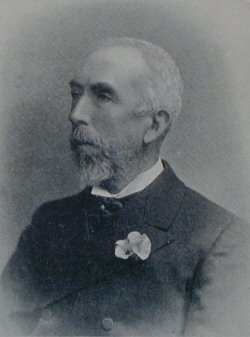 JOHN HONEYMAN
JOHN HONEYMAN JOHN HONEYMAN
JOHN HONEYMAN BORN at Glasgow, 11th August, 1831, and third son of the late John Honeyman,
J.P., of 21 Carlton Place, Glasgow, and Belmore, Dunbartonshire, a prominent
citizen and for several years one of the magistrates of Glasgow, the veteran
Glasgow architect was educated at Merchiston Castle School, 1841-46. Charles
Chalmers, brother of the celebrated divine, was then head of the school, and
among contemporaries, many of whom distinguished themselves in after life, were
Sir Wyville Thompson, sen., Professor Foster Heddle, Sir Robert Jardine (late
M.P. for Dumfriesshire), and Colonel Pratt, R.E. Intending at first to enter the
Church, Mr. Honeyman passed the arts curriculum at Glasgow University; but he
changed his mind, and, as he himself puts it, lived to edify the church in
another way. He served his apprenticeship as an architect with the late
Alexander Munro, and after spending a short time in London and on the Continent,
and studying ecclesiastical architecture in all the cathedral towns of England
and in many abroad, he engaged in practice on his own account in Glasgow. He
rapidly obtained a fair share of work. The first church he designed was the Free
West Church at Greenock, and the second was Lansdowne U.P. Church which, owing
to the great extension of the city westwards, has become a very conspicuous
object, but which, after an experience of half a century, the architect does not
now regard with unmixed satisfaction. In the busy following years his practice
was chiefly domestic and ecclesiastical. Out of the long array of his works one
warehouse building may be mentioned as of quite unusual construction, and an
early example of an attempt to treat iron not merely structurally but
architecturally. This is the warehouse at the south-east corner of Union Street
and Gordon Street. There may also be mentioned among his later works the
restoration of St. Michael's Church, Linlithgow, and Brechin Cathedral. More
recently, in conjunction with his partner, Mr. Keppie, he has designed such
buildings as Anderson's College Medical School and Queen Margaret's College
Anatomical School. And in the competition for Glasgow art Galleries two of the
six designs which received premiums came from the office of the firm, one being
by Mr. Honeyman and the other by Mr. Keppie.
From the beginning of his practice he has taken a great interest in archaeology,
and in 1885 he took part in the formation of the Glasgow Archaeological Society,
of which he was the first Honorary Secretary, and was in later years President.
In 1874 he was elected a Fellow of the Royal Institute of British Architects,
and for many successive years was chosen a member of the council of that body.
He has also been President of the Glasgow Institute of Architects, and of the
Sanitary and Social Economy Section of the Royal Glasgow Philosophical Society.
He has taken part in many social movements, and was a member of the Glasgow
Presbytery's Commission on the Housing of the Poor.
In 1892 he was elected an Associate of the Royal Scottish Academy, and in 1895
an Academician. In 1904 he received from the University of Glasgow the honorary
degree of LL.D.
Shortly after the inauguration of the Glasgow and West of Scotland Technical
College he was elected one of the governors, and he continued to lake an active
part in the work of the principal committees for fully eight years. Though
indications of failing sight caused him to retire, he continues to take a warm
interest in the work of that most valuable institution.
In 1854 he published his first brochure entitled "The Age of Glasgow Cathedral
and of the Effigy in the Crypt," his object being to correct erroneous dates
displayed in various parts of the building. Shortly afterwards, in 1856, he read
a paper (since published) on "The Drainage of Glasgow and the Purification of
the Clyde, with special reference to the Ventilation of Drains," and exhibited a
design for a trap with an eye on each side of the tongue, which was the
fore-runner of all the ventilating drain traps since invented, none of which
answer the purpose better. He subsequently published independently "Trades
Unionism, the Blight on British Industry and Commerce;" "The Dwellings of the
Poor;" "The Incidence of Taxation;" " Open Spaces in Towns;" and "Betterment;"
and, besides contributing to various periodicals, he was the author of papers
which appear in the published Transactions of the Royal Institute of British
Architects, the Royal Philosophical Society, the Sanitary Institute. the Royal
Institute of Public Health, the Sanitary Association, the Glasgow Archaeological
Society, the Royal Archaeological Institute, the Regality Club, the Scottish
Ecclesiological Society, and the Society for Psychical Research.
Among his other public services Mr. Honeyman took part in 1859 in raising the
first corps of volunteer artillery in Dunbartonshire, and he continued a
commissioned officer of that body for ten years.
In his early days he acquired a taste for boating, for which during school
holidays he had great facilities at his father's place on the Gareloch. While
residing at Skelmorlie, from 1872 till 1879, he had the pleasure of possessing a
yacht of his own, in which he and his wife and sons had many a pleasant and
eventful cruise along the beautiful west coast. Like many another lover of white
sails and blue water, he found at that busy period of his life that an
occasional cruise of ten days or so was the best possible means of regaining
vigour and enjoying mental rest; and his love for yachting, and his interest in
everything connected with it, has never flagged.
In 1889 Mr. Honeyman assumed as his partner Mr. John Keppie, who was already
well known as the able assistant of the late James Sellars, and to the great
loss of architecture in Glasgow the failure of his sight has within the last few
years compelled him to give up his professional work altogether.
Back to
Index of Glasgow Men (1909)